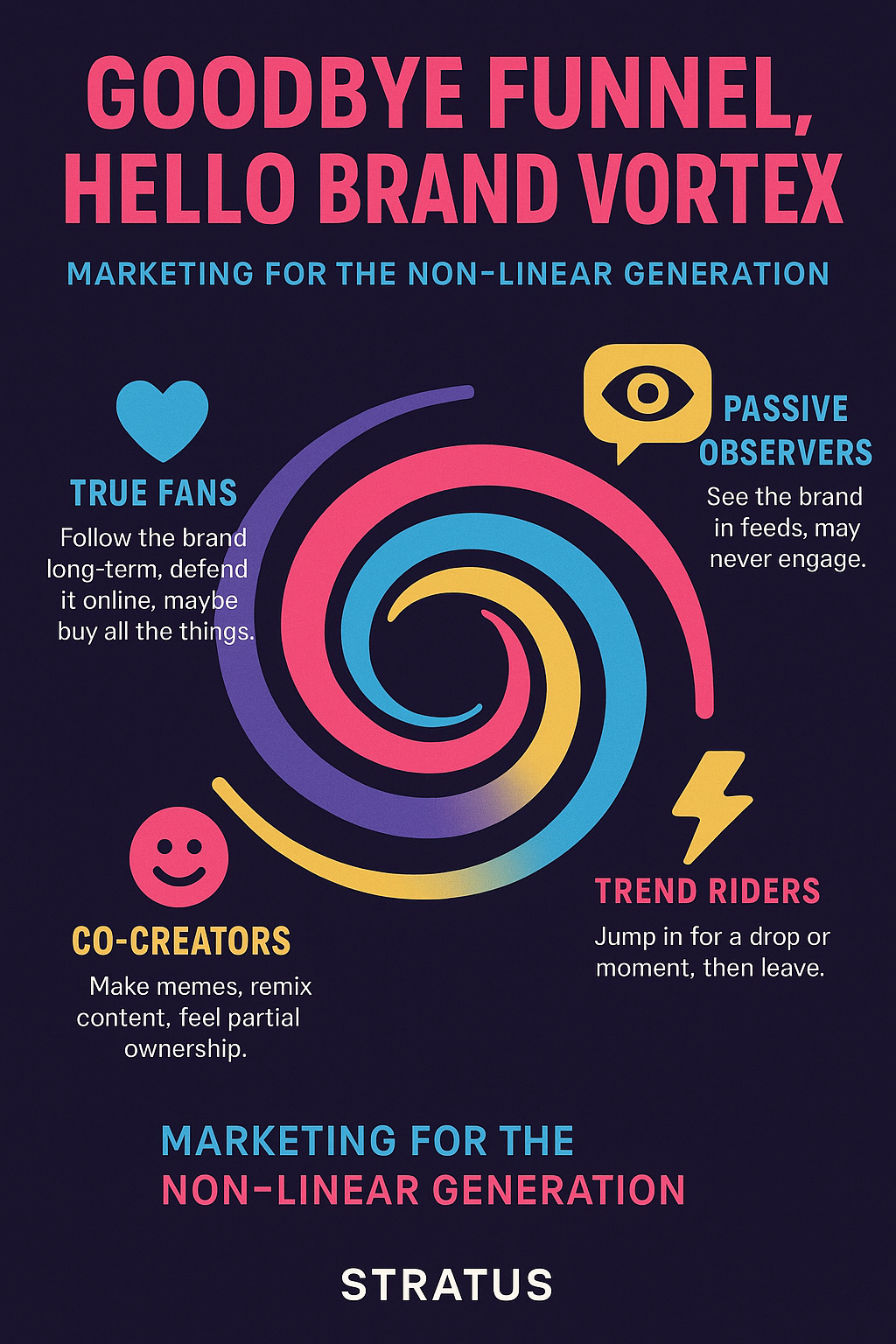The classic marketing funnel is dead—or at least dying a slow, meme-filled death. And if you’re looking for the culprit, look no further than Gen Z. This digital-native generation doesn’t “convert” in neat stages. They orbit, they observe, they bounce in and out of engagement loops, and they don’t care about your rigid funnels.
What’s taken its place? A swirling, ever-evolving model known as the Brand Vortex—a new way to understand how consumers (especially younger ones) interact with your brand. It’s messy. It’s dynamic. And it’s the future of brand marketing.
In this post, we’ll break down how the Brand Vortex works, why it matters, and most importantly—how to build for it.

What is the Brand Vortex?
The Brand Vortex is a non-linear model of brand interaction where people don’t follow a tidy journey from awareness to purchase to loyalty. Instead, they flow in and out of varying levels of engagement. It reflects real-world, digital behavior far better than the funnel ever did.
Here’s how the vortex breaks down:
🌀 1. Passive Observers
These are users who have seen your brand. Maybe they caught a meme, a retweet, a TikTok, or someone they follow wearing your merch. They don’t engage—yet. But they’ve seen you. That’s a win.
Your strategy here: Be everywhere. Use snackable, native content across channels to build brand surface area. Think memes, reactive posts, influencer reposts, and contextual content that feels like it belongs in a scroll.
🌀 2. Trend Riders
These users ride the wave when your brand is “hot.” Maybe you dropped a product collab, went viral, or got shouted out by a creator. They’re here for the moment—but they might vanish afterward.
Your strategy here: Maximize spikes. Build launch moments around culture—use urgency, drops, and exclusives. Create FOMO and don’t be afraid to lean into hype culture. The key is to use trend moments as gravity to pull in new people.
🌀 3. Co-Creators
This is the remix generation. They take your content, twist it, meme it, respond to it, and often make it better. Co-creators feel partial ownership over your brand. They don’t just watch—they participate.
Your strategy here: Encourage play. Give your audience raw materials—templates, audio, hashtags, challenges—to remix. Celebrate their contributions. Build community dashboards or fan-made galleries. Reward creative engagement with spotlight features or even product input.
🌀 4. True Fans
They defend you online. They buy everything you release. They make brand fan accounts. They wear your merch without being paid. These are your inner-core vortex champions.
Your strategy here: Treat them like insiders. Give them first access, create community experiences, send surprise thank-yous, and give them a voice in the future of your brand. Turn them into brand collaborators, not just consumers.
Why the Traditional Funnel Doesn’t Work Anymore
Let’s be honest—the linear funnel was never that realistic to begin with. But Gen Z has officially broken it.
Here’s why:
- Entry points are everywhere: A TikTok duet, a creator shoutout, or a meme on Twitter might be someone’s first exposure to your brand.
- Brand loyalty is fluid: Today’s fan might be tomorrow’s critic (and vice versa).
- Culture moves fast: By the time you’ve “nurtured” someone with a lead sequence, they’ve already joined a Discord, bought a drop, and moved on.
You can’t shepherd people through a funnel. You can only build enough gravity to keep them coming back to your orbit.
How to Build for the Brand Vortex: 8 Actionable Tips
Here’s how to make sure your brand survives—and thrives—in the Vortex era:
✅ 1. Shift From Campaigns to Content Systems
Campaigns end. Content ecosystems don’t. Build a library of reusable, remixable content. Think: branded audio clips, short-form templates, meme formats, and visual snippets that creators can use again and again.
✅ 2. Invest in Creator Relationships
Work with creators who embody your brand voice—not just influencers with large followings. Give them creative freedom. The more organic it feels, the better it performs.
✅ 3. Structure Your Content by Energy Level
Map content to engagement intensity:
- 💤 For Passive Observers: Eye-catching, scroll-stopping memes and short-form video.
- 🚀 For Trend Riders: Flash sales, collabs, creator takeovers.
- 🎨 For Co-Creators: Remix contests, duets, green-screen-ready assets.
- 🫶 For True Fans: Behind-the-scenes, founder messages, Discord events.
✅ 4. Build Feedback Loops
Create systems where users can influence the brand. Run polls, host UGC challenges, and actually implement suggestions. This makes users feel valued—and keeps them orbiting.
✅ 5. Prioritize Cultural Fluency
Be relevant to internet culture without trying too hard. Study the language, tone, and style of your niche. Don’t just insert yourself into trends—understand them first.
✅ 6. Design With Mobility in Mind
Your content should travel. Can it be reshared on stories? Clipped into Reels? Quoted on X? If not, rework it. Vortex-era content has to move across platforms easily.
✅ 7. Use Community as Content
Screenshot comments. Feature fan art. Stitch fan responses. Let your community help you build brand gravity. Social proof isn’t just about testimonials—it’s about vibe.
✅ 8. Rethink Success Metrics
Funnel KPIs won’t cut it anymore. Track orbit-level metrics:
- Meme shares
- Save-to-like ratio
- Discord engagement
- Co-creation entries
- Repeat traffic sources
These tell you more about your brand’s pull than clicks and opens ever will.
Final Thought: Gravity Over Funnels
The Brand Vortex isn’t a theory. It’s what’s already happening.
If you’re still stuck optimizing your “middle of the funnel,” you’re missing the point. You need to be creating enough brand gravity that people keep entering and re-entering your orbit at all stages. Sometimes they’ll buy. Sometimes they’ll share. Sometimes they’ll just vibe.
But the more energy you invest into orbit-building content, creator collaborations, and community scaffolding, the more resilient your brand becomes.
The funnel is dead. Long live the vortex.

Hi there! I’m Scott, and I am the principal consultant and thought leader behind Stratus Analytics. I have a Master of Science degree in marketing analytics, and I’ve have been providing freelance digital marketing services for over 20 years. Additionally, I have written several books on marketing which you can find here on Amazon or this website.
DISCLAIMER: Due to my work in the packaging industry, I cannot take on freelance clients within the packaging manufacturing space. I do not want to provide disservice to your vision or my employer. Thank you for understanding.
